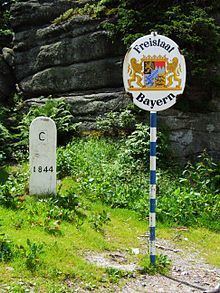 | ||
The Czech Republic–Germany border is the international border between the Czech Republic and Germany. It forms a 815 kilometres (506 mi) arc extending from Austria at the south to Poland at the north.
Contents
Rivers
Several rivers cross this border, or form portions of it. These include:
History
The border comes from the old border between German Empire and the Austrian Empire.
In the period 1945-1990, the border formed part of the Iron curtain and was heavily fenced and strictly guarded.
The Czech Republic joined the Schengen Area in 2007. This meant that all passport checks were removed along the border in December 2007. The limitations on Czechs working in Germany expired in April 2011.
References
Czech Republic–Germany border Wikipedia(Text) CC BY-SA
